[English] 日本語
 Yorodumi
Yorodumi- EMDB-20285: Cryo-EM structure of Urocortin 1-bound Corticotropin-releasing fa... -
+ Open data
Open data
- Basic information
Basic information
| Entry | Database: EMDB / ID: EMD-20285 | |||||||||
|---|---|---|---|---|---|---|---|---|---|---|
| Title | Cryo-EM structure of Urocortin 1-bound Corticotropin-releasing factor 2 receptor in complex with Gs protein and Nb35 | |||||||||
 Map data Map data | ||||||||||
 Sample Sample |
| |||||||||
 Keywords Keywords | Corticotropin-releasing factor 2 receptor / urocortins1 / Gs protein / GPCR / SIGNALING PROTEIN | |||||||||
| Function / homology |  Function and homology information Function and homology informationhistone deacetylase inhibitor activity / corticotrophin-releasing factor receptor activity / corticotropin-releasing hormone receptor 2 binding / positive regulation of corticotropin secretion / positive regulation of behavioral fear response / varicosity / negative regulation of hormone secretion / response to auditory stimulus / positive regulation of cAMP-mediated signaling / drinking behavior ...histone deacetylase inhibitor activity / corticotrophin-releasing factor receptor activity / corticotropin-releasing hormone receptor 2 binding / positive regulation of corticotropin secretion / positive regulation of behavioral fear response / varicosity / negative regulation of hormone secretion / response to auditory stimulus / positive regulation of cAMP-mediated signaling / drinking behavior / negative regulation of appetite / corticotropin-releasing hormone receptor 1 binding / neuropeptide hormone activity / positive regulation of vascular permeability / negative regulation of cell size / G protein-coupled peptide receptor activity / Class B/2 (Secretin family receptors) / negative regulation of feeding behavior / response to pain / positive regulation of calcium ion import / startle response / associative learning / PKA activation in glucagon signalling / peptide hormone binding / social behavior / hair follicle placode formation / developmental growth / neuropeptide signaling pathway / positive regulation of collagen biosynthetic process / D1 dopamine receptor binding / Synthesis, secretion, and deacylation of Ghrelin / intracellular transport / T cell migration / D2 dopamine receptor binding / Adenylate cyclase inhibitory pathway / positive regulation of protein localization to cell cortex / renal water homeostasis / Hedgehog 'off' state / regulation of cAMP-mediated signaling / G protein-coupled serotonin receptor binding / adenylate cyclase-activating adrenergic receptor signaling pathway / activation of adenylate cyclase activity / cellular response to forskolin / response to glucocorticoid / axon terminus / regulation of mitotic spindle organization / regulation of synaptic transmission, glutamatergic / cellular response to glucagon stimulus / positive regulation of cardiac muscle contraction / negative regulation of blood pressure / adenylate cyclase activator activity / regulation of insulin secretion / aerobic respiration / adenylate cyclase-inhibiting G protein-coupled receptor signaling pathway / trans-Golgi network membrane / positive regulation of DNA replication / positive regulation of translation / Regulation of insulin secretion / female pregnancy / long-term synaptic potentiation / G protein-coupled receptor binding / negative regulation of inflammatory response to antigenic stimulus / sensory perception of sound / bone development / G-protein beta/gamma-subunit complex binding / adenylate cyclase-modulating G protein-coupled receptor signaling pathway / Olfactory Signaling Pathway / Activation of the phototransduction cascade / adenylate cyclase-activating G protein-coupled receptor signaling pathway / G beta:gamma signalling through PLC beta / Presynaptic function of Kainate receptors / Thromboxane signalling through TP receptor / G protein-coupled acetylcholine receptor signaling pathway / G protein activity / G-protein activation / Activation of G protein gated Potassium channels / Inhibition of voltage gated Ca2+ channels via Gbeta/gamma subunits / platelet aggregation / Prostacyclin signalling through prostacyclin receptor / Glucagon signaling in metabolic regulation / G beta:gamma signalling through CDC42 / response to peptide hormone / cognition / G beta:gamma signalling through BTK / ADP signalling through P2Y purinoceptor 12 / Sensory perception of sweet, bitter, and umami (glutamate) taste / Synthesis, secretion, and inactivation of Glucagon-like Peptide-1 (GLP-1) / photoreceptor disc membrane / Glucagon-type ligand receptors / Adrenaline,noradrenaline inhibits insulin secretion / Vasopressin regulates renal water homeostasis via Aquaporins / positive regulation of interleukin-6 production / G alpha (z) signalling events / Glucagon-like Peptide-1 (GLP1) regulates insulin secretion / vasodilation / ADORA2B mediated anti-inflammatory cytokines production / cellular response to catecholamine stimulus / sensory perception of taste / ADP signalling through P2Y purinoceptor 1 / G beta:gamma signalling through PI3Kgamma Similarity search - Function | |||||||||
| Biological species |  Homo sapiens (human) / synthetic construct (others) Homo sapiens (human) / synthetic construct (others) | |||||||||
| Method | single particle reconstruction / cryo EM / Resolution: 2.8 Å | |||||||||
 Authors Authors | Ma S / Shen Q | |||||||||
| Funding support |  United States, United States,  China, 2 items China, 2 items
| |||||||||
 Citation Citation |  Journal: Mol Cell / Year: 2020 Journal: Mol Cell / Year: 2020Title: Molecular Basis for Hormone Recognition and Activation of Corticotropin-Releasing Factor Receptors. Authors: Shanshan Ma / Qingya Shen / Li-Hua Zhao / Chunyou Mao / X Edward Zhou / Dan-Dan Shen / Parker W de Waal / Peng Bi / Chuntao Li / Yi Jiang / Ming-Wei Wang / Patrick M Sexton / Denise Wootten ...Authors: Shanshan Ma / Qingya Shen / Li-Hua Zhao / Chunyou Mao / X Edward Zhou / Dan-Dan Shen / Parker W de Waal / Peng Bi / Chuntao Li / Yi Jiang / Ming-Wei Wang / Patrick M Sexton / Denise Wootten / Karsten Melcher / Yan Zhang / H Eric Xu /    Abstract: Corticotropin-releasing factor (CRF) and the three related peptides urocortins 1-3 (UCN1-UCN3) are endocrine hormones that control the stress responses by activating CRF1R and CRF2R, two members of ...Corticotropin-releasing factor (CRF) and the three related peptides urocortins 1-3 (UCN1-UCN3) are endocrine hormones that control the stress responses by activating CRF1R and CRF2R, two members of class B G-protein-coupled receptors (GPCRs). Here, we present two cryoelectron microscopy (cryo-EM) structures of UCN1-bound CRF1R and CRF2R with the stimulatory G protein. In both structures, UCN1 adopts a single straight helix with its N terminus dipped into the receptor transmembrane bundle. Although the peptide-binding residues in CRF1R and CRF2R are different from other members of class B GPCRs, the residues involved in receptor activation and G protein coupling are conserved. In addition, both structures reveal bound cholesterol molecules to the receptor transmembrane helices. Our structures define the basis of ligand-binding specificity in the CRF receptor-hormone system, establish a common mechanism of class B GPCR activation and G protein coupling, and provide a paradigm for studying membrane protein-lipid interactions for class B GPCRs. | |||||||||
| History |
|
- Structure visualization
Structure visualization
| Movie |
 Movie viewer Movie viewer |
|---|---|
| Structure viewer | EM map:  SurfView SurfView Molmil Molmil Jmol/JSmol Jmol/JSmol |
| Supplemental images |
- Downloads & links
Downloads & links
-EMDB archive
| Map data |  emd_20285.map.gz emd_20285.map.gz | 35.9 MB |  EMDB map data format EMDB map data format | |
|---|---|---|---|---|
| Header (meta data) |  emd-20285-v30.xml emd-20285-v30.xml emd-20285.xml emd-20285.xml | 16.9 KB 16.9 KB | Display Display |  EMDB header EMDB header |
| Images |  emd_20285.png emd_20285.png | 51.3 KB | ||
| Filedesc metadata |  emd-20285.cif.gz emd-20285.cif.gz | 6.5 KB | ||
| Archive directory |  http://ftp.pdbj.org/pub/emdb/structures/EMD-20285 http://ftp.pdbj.org/pub/emdb/structures/EMD-20285 ftp://ftp.pdbj.org/pub/emdb/structures/EMD-20285 ftp://ftp.pdbj.org/pub/emdb/structures/EMD-20285 | HTTPS FTP |
-Validation report
| Summary document |  emd_20285_validation.pdf.gz emd_20285_validation.pdf.gz | 563.9 KB | Display |  EMDB validaton report EMDB validaton report |
|---|---|---|---|---|
| Full document |  emd_20285_full_validation.pdf.gz emd_20285_full_validation.pdf.gz | 563.4 KB | Display | |
| Data in XML |  emd_20285_validation.xml.gz emd_20285_validation.xml.gz | 5.8 KB | Display | |
| Data in CIF |  emd_20285_validation.cif.gz emd_20285_validation.cif.gz | 6.7 KB | Display | |
| Arichive directory |  https://ftp.pdbj.org/pub/emdb/validation_reports/EMD-20285 https://ftp.pdbj.org/pub/emdb/validation_reports/EMD-20285 ftp://ftp.pdbj.org/pub/emdb/validation_reports/EMD-20285 ftp://ftp.pdbj.org/pub/emdb/validation_reports/EMD-20285 | HTTPS FTP |
-Related structure data
| Related structure data |  6pb1MC  6pb0C M: atomic model generated by this map C: citing same article ( |
|---|---|
| Similar structure data |
- Links
Links
| EMDB pages |  EMDB (EBI/PDBe) / EMDB (EBI/PDBe) /  EMDataResource EMDataResource |
|---|---|
| Related items in Molecule of the Month |
- Map
Map
| File |  Download / File: emd_20285.map.gz / Format: CCP4 / Size: 38.4 MB / Type: IMAGE STORED AS FLOATING POINT NUMBER (4 BYTES) Download / File: emd_20285.map.gz / Format: CCP4 / Size: 38.4 MB / Type: IMAGE STORED AS FLOATING POINT NUMBER (4 BYTES) | ||||||||||||||||||||||||||||||||||||||||||||||||||||||||||||||||||||
|---|---|---|---|---|---|---|---|---|---|---|---|---|---|---|---|---|---|---|---|---|---|---|---|---|---|---|---|---|---|---|---|---|---|---|---|---|---|---|---|---|---|---|---|---|---|---|---|---|---|---|---|---|---|---|---|---|---|---|---|---|---|---|---|---|---|---|---|---|---|
| Projections & slices | Image control
Images are generated by Spider. | ||||||||||||||||||||||||||||||||||||||||||||||||||||||||||||||||||||
| Voxel size | X=Y=Z: 1.014 Å | ||||||||||||||||||||||||||||||||||||||||||||||||||||||||||||||||||||
| Density |
| ||||||||||||||||||||||||||||||||||||||||||||||||||||||||||||||||||||
| Symmetry | Space group: 1 | ||||||||||||||||||||||||||||||||||||||||||||||||||||||||||||||||||||
| Details | EMDB XML:
CCP4 map header:
| ||||||||||||||||||||||||||||||||||||||||||||||||||||||||||||||||||||
-Supplemental data
- Sample components
Sample components
-Entire : Urocortin 1-bound corticotropin-releasing factor 2 receptor in co...
| Entire | Name: Urocortin 1-bound corticotropin-releasing factor 2 receptor in complex with Gs protein |
|---|---|
| Components |
|
-Supramolecule #1: Urocortin 1-bound corticotropin-releasing factor 2 receptor in co...
| Supramolecule | Name: Urocortin 1-bound corticotropin-releasing factor 2 receptor in complex with Gs protein type: complex / ID: 1 / Parent: 0 / Macromolecule list: #1-#6 |
|---|---|
| Source (natural) | Organism:  Homo sapiens (human) Homo sapiens (human) |
-Macromolecule #1: Corticotropin-releasing factor receptor 2
| Macromolecule | Name: Corticotropin-releasing factor receptor 2 / type: protein_or_peptide / ID: 1 / Number of copies: 1 / Enantiomer: LEVO |
|---|---|
| Source (natural) | Organism:  Homo sapiens (human) Homo sapiens (human) |
| Molecular weight | Theoretical: 45.116375 KDa |
| Recombinant expression | Organism:  |
| Sequence | String: DAALLHSLLE ANCSLALAEE LLLDGWGPPL DPEGPYSYCN TTLDQIGTCW PRSAAGALVE RPCPEYFNGV KYNTTRNAYR ECLENGTWA SKINYSQCEP ILDDKQRKYD LHYRIALVVN YLGHCVSVAA LVAAFLLFLA LRSIRCLRNV IHWNLITTFI L RNVMWFLL ...String: DAALLHSLLE ANCSLALAEE LLLDGWGPPL DPEGPYSYCN TTLDQIGTCW PRSAAGALVE RPCPEYFNGV KYNTTRNAYR ECLENGTWA SKINYSQCEP ILDDKQRKYD LHYRIALVVN YLGHCVSVAA LVAAFLLFLA LRSIRCLRNV IHWNLITTFI L RNVMWFLL QLVDHEVHES NEVWCRCITT IFNYFVVTNF FWMFVEGCYL HTAIVMTYST ERLRKCLFLF IGWCIPFPII VA WAIGKLY YENEQCWFGK EPGDLVDYIY QGPIILVLLI NFVFLFNIVR ILMTKLRAST TSETIQYRKA VKATLVLLPL LGI TYMLFF VNPGEDDLSQ IMFIYFNSFL QSFQGFFVSV FYCFFNGEVR SAVRKRWHRW QDHHSLRVPM A UniProtKB: Corticotropin-releasing factor receptor 2 |
-Macromolecule #2: Urocortin
| Macromolecule | Name: Urocortin / type: protein_or_peptide / ID: 2 / Number of copies: 1 / Enantiomer: LEVO |
|---|---|
| Source (natural) | Organism:  Homo sapiens (human) Homo sapiens (human) |
| Molecular weight | Theoretical: 4.703277 KDa |
| Sequence | String: DNPSLSIDLT FHLLRTLLEL ARTQSQRERA EQNRIIFDSV UniProtKB: Urocortin |
-Macromolecule #3: Guanine nucleotide-binding protein G(s) subunit alpha isoforms sh...
| Macromolecule | Name: Guanine nucleotide-binding protein G(s) subunit alpha isoforms short,Guanine nucleotide-binding protein G(i) subunit alpha-1,Guanine nucleotide-binding protein G(s) subunit alpha isoforms short type: protein_or_peptide / ID: 3 / Number of copies: 1 / Enantiomer: LEVO |
|---|---|
| Source (natural) | Organism:  Homo sapiens (human) Homo sapiens (human) |
| Molecular weight | Theoretical: 43.897789 KDa |
| Recombinant expression | Organism:  |
| Sequence | String: MGCLGNSKTE DQRNEEKAQR EANKKIEKQL QKDKQVYRAT HRLLLLGAGE SGKSTIVKQM RILHVNGYSE EECKQYKAVV YSNTIQSII AIIRAMGRLK IDFGDSARAD DARQLFVLAG AAEEGFMTAE LAGVIKRLWK DSGVQACFNR SREYQLNDSA A YYLNDLDR ...String: MGCLGNSKTE DQRNEEKAQR EANKKIEKQL QKDKQVYRAT HRLLLLGAGE SGKSTIVKQM RILHVNGYSE EECKQYKAVV YSNTIQSII AIIRAMGRLK IDFGDSARAD DARQLFVLAG AAEEGFMTAE LAGVIKRLWK DSGVQACFNR SREYQLNDSA A YYLNDLDR IAQPNYIPTQ QDVLRTRVKT TGIFETKFQV DKVNFHMFDV GAQRDERRKW IQCFNDVTAI IFVVASSSYN MV IREDNQT NRLQEALNLF KSIWNNRWLR TISVILFLNK QDLLAEKVLA GKSKIEDYFP EFARYTTPED ATPEPGEDPR VTR AKYFIR DEFLRISTAS GDGRHYCYPH FTCSVDTENI RRVFNDCRDI IQRMHLRQYE LL UniProtKB: Guanine nucleotide-binding protein G(s) subunit alpha isoforms short, Guanine nucleotide-binding protein G(i) subunit alpha-1, Guanine nucleotide-binding protein G(s) subunit alpha isoforms short |
-Macromolecule #4: Guanine nucleotide-binding protein G(I)/G(S)/G(T) subunit beta-1
| Macromolecule | Name: Guanine nucleotide-binding protein G(I)/G(S)/G(T) subunit beta-1 type: protein_or_peptide / ID: 4 / Number of copies: 1 / Enantiomer: LEVO |
|---|---|
| Source (natural) | Organism:  Homo sapiens (human) Homo sapiens (human) |
| Molecular weight | Theoretical: 37.915496 KDa |
| Recombinant expression | Organism:  |
| Sequence | String: MGSLLQSELD QLRQEAEQLK NQIRDARKAC ADATLSQITN NIDPVGRIQM RTRRTLRGHL AKIYAMHWGT DSRLLVSASQ DGKLIIWDS YTTNKVHAIP LRSSWVMTCA YAPSGNYVAC GGLDNICSIY NLKTREGNVR VSRELAGHTG YLSCCRFLDD N QIVTSSGD ...String: MGSLLQSELD QLRQEAEQLK NQIRDARKAC ADATLSQITN NIDPVGRIQM RTRRTLRGHL AKIYAMHWGT DSRLLVSASQ DGKLIIWDS YTTNKVHAIP LRSSWVMTCA YAPSGNYVAC GGLDNICSIY NLKTREGNVR VSRELAGHTG YLSCCRFLDD N QIVTSSGD TTCALWDIET GQQTTTFTGH TGDVMSLSLA PDTRLFVSGA CDASAKLWDV REGMCRQTFT GHESDINAIC FF PNGNAFA TGSDDATCRL FDLRADQELM TYSHDNIICG ITSVSFSKSG RLLLAGYDDF NCNVWDALKA DRAGVLAGHD NRV SCLGVT DDGMAVATGS WDSFLKIWN UniProtKB: Guanine nucleotide-binding protein G(I)/G(S)/G(T) subunit beta-1 |
-Macromolecule #5: Guanine nucleotide-binding protein G(I)/G(S)/G(O) subunit gamma-2
| Macromolecule | Name: Guanine nucleotide-binding protein G(I)/G(S)/G(O) subunit gamma-2 type: protein_or_peptide / ID: 5 / Number of copies: 1 / Enantiomer: LEVO |
|---|---|
| Source (natural) | Organism:  Homo sapiens (human) Homo sapiens (human) |
| Molecular weight | Theoretical: 7.861143 KDa |
| Recombinant expression | Organism:  |
| Sequence | String: MASNNTASIA QARKLVEQLK MEANIDRIKV SKAAADLMAY CEAHAKEDPL LTPVPASENP FREKKFFCAI L UniProtKB: Guanine nucleotide-binding protein G(I)/G(S)/G(O) subunit gamma-2 |
-Macromolecule #6: Nanobody 35
| Macromolecule | Name: Nanobody 35 / type: protein_or_peptide / ID: 6 / Number of copies: 1 / Enantiomer: LEVO |
|---|---|
| Source (natural) | Organism: synthetic construct (others) |
| Molecular weight | Theoretical: 15.343019 KDa |
| Recombinant expression | Organism:  |
| Sequence | String: MAQVQLQESG GGLVQPGGSL RLSCAASGFT FSNYKMNWVR QAPGKGLEWV SDISQSGASI SYTGSVKGRF TISRDNAKNT LYLQMNSLK PEDTAVYYCA RCPAPFTRDC FDVTSTTYAY RGQGTQVTVS SHHHHHHEPE A |
-Macromolecule #7: CHOLESTEROL
| Macromolecule | Name: CHOLESTEROL / type: ligand / ID: 7 / Number of copies: 4 / Formula: CLR |
|---|---|
| Molecular weight | Theoretical: 386.654 Da |
| Chemical component information |  ChemComp-CLR: |
-Macromolecule #8: PALMITIC ACID
| Macromolecule | Name: PALMITIC ACID / type: ligand / ID: 8 / Number of copies: 5 / Formula: PLM |
|---|---|
| Molecular weight | Theoretical: 256.424 Da |
| Chemical component information |  ChemComp-PLM: |
-Experimental details
-Structure determination
| Method | cryo EM |
|---|---|
 Processing Processing | single particle reconstruction |
| Aggregation state | particle |
- Sample preparation
Sample preparation
| Buffer | pH: 7.4 |
|---|---|
| Grid | Details: unspecified |
| Vitrification | Cryogen name: ETHANE |
- Electron microscopy
Electron microscopy
| Microscope | FEI TITAN KRIOS |
|---|---|
| Image recording | Film or detector model: GATAN K2 BASE (4k x 4k) / Average electron dose: 66.0 e/Å2 |
| Electron beam | Acceleration voltage: 300 kV / Electron source:  FIELD EMISSION GUN FIELD EMISSION GUN |
| Electron optics | Illumination mode: FLOOD BEAM / Imaging mode: BRIGHT FIELD |
| Experimental equipment |  Model: Titan Krios / Image courtesy: FEI Company |
- Image processing
Image processing
| Startup model | Type of model: NONE |
|---|---|
| Final reconstruction | Resolution.type: BY AUTHOR / Resolution: 2.8 Å / Resolution method: FSC 0.143 CUT-OFF / Number images used: 67569 |
| Initial angle assignment | Type: NOT APPLICABLE |
| Final angle assignment | Type: NOT APPLICABLE |
 Movie
Movie Controller
Controller







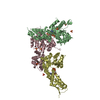

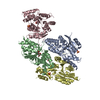
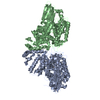
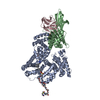
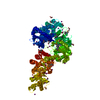


















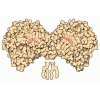









 Z (Sec.)
Z (Sec.) Y (Row.)
Y (Row.) X (Col.)
X (Col.)





















